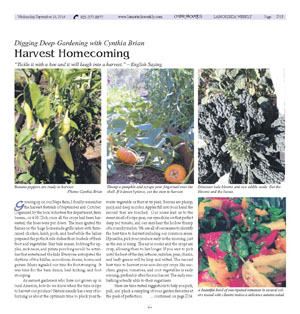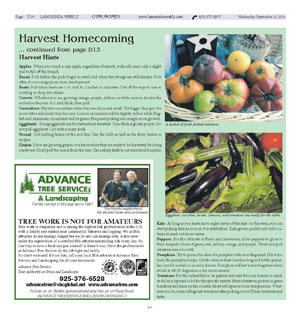|
|
Published September 10th, 2014
|
Digging Deep-Gardening with Cynthia Brian
Harvest Homecoming
|
|
|
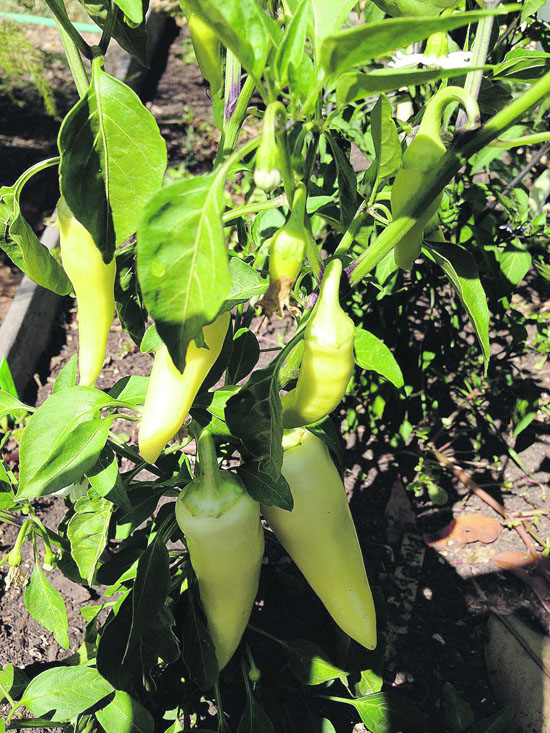 |
| Banana peppers are ready to harvest. Photos Cynthia Brian |
Growing up on our Napa farm, I fondly remember the harvest festivals of September and October. Organized by the local volunteer fire department, farm bureau, or 4-H Club, once all the crops had been harvested, the hoes were put down. The men ignited the flames on the huge homemade grills laden with farm-raised chicken, lamb, pork, and beef while the ladies prepared the potluck side dishes from bushels of fresh fruit and vegetables. Hay bale mazes, bobbing for apples, sack races, and pinata punching would be activities that entertained the kids. Everyone anticipated the rhythms of the fiddles, accordions, drums, horns, and guitars. Music signaled our time for foot stomping. It was time for the barn dance, heel kicking, and foot stomping.
 As earnest gardeners who have not grown up in rural America, how do we know when the time is ripe to harvest our produce? Nature usually has a way of informing us about the optimum time to pluck your favorite vegetable or fruit at its peak. Berries are plump, juicy, and deep in color. Apples fall into your hand the second they are touched. Our noses lead us to the sweet smell of a ripe pear, our eyes shine on that perfect deep red tomato, and our ears hear the hollow thump of a crunchy melon. We use all of our senses to identify the best time to harvest including our common sense. If possible, pick your produce early in the morning, just as the sun is rising. The air is cooler and the crops are crisp, allowing them to last longer. If you wait to pick until the heat of the day, lettuces, radishes, peas, chards, and leafy greens will be limp and wilted. The second best time to harvest your non-droopy crops like zucchini, grapes, tomatoes, and root vegetables is early evening, preferably after the sun has set. The early sunbathing actually adds to their sugariness.
As earnest gardeners who have not grown up in rural America, how do we know when the time is ripe to harvest our produce? Nature usually has a way of informing us about the optimum time to pluck your favorite vegetable or fruit at its peak. Berries are plump, juicy, and deep in color. Apples fall into your hand the second they are touched. Our noses lead us to the sweet smell of a ripe pear, our eyes shine on that perfect deep red tomato, and our ears hear the hollow thump of a crunchy melon. We use all of our senses to identify the best time to harvest including our common sense. If possible, pick your produce early in the morning, just as the sun is rising. The air is cooler and the crops are crisp, allowing them to last longer. If you wait to pick until the heat of the day, lettuces, radishes, peas, chards, and leafy greens will be limp and wilted. The second best time to harvest your non-droopy crops like zucchini, grapes, tomatoes, and root vegetables is early evening, preferably after the sun has set. The early sunbathing actually adds to their sugariness.
 Here are time-tested suggestions to help you pick, pull, and pluck a sampling of your garden favorites at the peak of perfection.
Here are time-tested suggestions to help you pick, pull, and pluck a sampling of your garden favorites at the peak of perfection.
 Harvest Hints
Harvest Hints

 Apples: When you touch a ripe apple, regardless of variety, it should need only a slight pull to fall off the branch.
Apples: When you touch a ripe apple, regardless of variety, it should need only a slight pull to fall off the branch.
 Beans: Pick before the pods begin to swell and when the strings are still slender. Pick often to encourage more bean development.
Beans: Pick before the pods begin to swell and when the strings are still slender. Pick often to encourage more bean development.
 Beets: Pull when beets are 1 1/2 inch to 2 inches in diameter. Cut off the tops to use in cooking or chop into salads.
Beets: Pull when beets are 1 1/2 inch to 2 inches in diameter. Cut off the tops to use in cooking or chop into salads.
 Carrots: Whether you are growing orange, purple, yellow, or white carrots, loosen the soil when they are 1/2-1 inch thick, then pull.
Carrots: Whether you are growing orange, purple, yellow, or white carrots, loosen the soil when they are 1/2-1 inch thick, then pull.
 Cucumbers: Harvest cucumbers when they are shiny and small. The bigger they get, the more bitter and seedy they become. Lemon cucumbers will be slightly yellow while English and Armenian cucumbers will be green. Frequent picking encourages more growth.
Cucumbers: Harvest cucumbers when they are shiny and small. The bigger they get, the more bitter and seedy they become. Lemon cucumbers will be slightly yellow while English and Armenian cucumbers will be green. Frequent picking encourages more growth.
 Eggplants: Young eggplants are the tastiest and sweetest. Their flesh is glossy purple. Do not pull eggplants. Cut with a sharp knife.
Eggplants: Young eggplants are the tastiest and sweetest. Their flesh is glossy purple. Do not pull eggplants. Cut with a sharp knife.
 Fennel: Cut bulbing fennel at the soil line. Use the bulb as well as the ferny leaves in recipes.
Fennel: Cut bulbing fennel at the soil line. Use the bulb as well as the ferny leaves in recipes.
 Grapes: If you are growing grapes, you know when they are ready to be harvested by doing a taste test. Don't pull the bunch from the vine. Use a sharp knife to cut individual bunches.
Grapes: If you are growing grapes, you know when they are ready to be harvested by doing a taste test. Don't pull the bunch from the vine. Use a sharp knife to cut individual bunches.
 Kale: As long as you leave six to eight leaves of the kale on the stem, you can start picking kale as soon as it is established. Kale grows quickly and will continue to send out more leaves.
Kale: As long as you leave six to eight leaves of the kale on the stem, you can start picking kale as soon as it is established. Kale grows quickly and will continue to send out more leaves.
 Peppers: For the ultimate in flavor and sweetness, allow peppers to grow to their deepest colors of green, red, yellow, orange, and purple. Twist and pick whatever size you wish.
Peppers: For the ultimate in flavor and sweetness, allow peppers to grow to their deepest colors of green, red, yellow, orange, and purple. Twist and pick whatever size you wish.
 Pumpkins: Try to pierce the skin of a pumpkin with your fingernail. If it is too hard, the pumpkin is ripe. Cut the stem at least 3 inches long and let the pumpkin cure for a week or more in the sun. Pumpkins will last a very long time when stored at 48-50 degrees in a dry environment.
Pumpkins: Try to pierce the skin of a pumpkin with your fingernail. If it is too hard, the pumpkin is ripe. Cut the stem at least 3 inches long and let the pumpkin cure for a week or more in the sun. Pumpkins will last a very long time when stored at 48-50 degrees in a dry environment.
 Tomatoes: For the richest flavor, be patient and wait for your tomato to reach its full sun-ripened color for the specific variety. If rain threatens, pick your green tomatoes and leave on the counter. Most will ripen at room temperature. Whatever you do, never refrigerate tomatoes after picking or you'll lose nutrients and taste.
Tomatoes: For the richest flavor, be patient and wait for your tomato to reach its full sun-ripened color for the specific variety. If rain threatens, pick your green tomatoes and leave on the counter. Most will ripen at room temperature. Whatever you do, never refrigerate tomatoes after picking or you'll lose nutrients and taste.
 The end of crop harvesting heralds the beginning of autumn everywhere as a time for rejoicing. Although in cities, towns, and suburbia attending a barn dance may not be in the cards, there are a number of festivals to celebrate the times. Check Lamorinda Weekly's "Not to be Missed" section for fun events for the entire family during the autumn harvest season.
The end of crop harvesting heralds the beginning of autumn everywhere as a time for rejoicing. Although in cities, towns, and suburbia attending a barn dance may not be in the cards, there are a number of festivals to celebrate the times. Check Lamorinda Weekly's "Not to be Missed" section for fun events for the entire family during the autumn harvest season.

 For a day of old fashioned entertainment and activities, be sure to attend the 2014 Pear and Wine Festival at Moraga Commons from 10 a.m. to 4 p.m. Saturday, Sept. 27 for music, food, wine, crafts, kids zone, and the Toast to Moraga 40th Anniversary Celebration.
For a day of old fashioned entertainment and activities, be sure to attend the 2014 Pear and Wine Festival at Moraga Commons from 10 a.m. to 4 p.m. Saturday, Sept. 27 for music, food, wine, crafts, kids zone, and the Toast to Moraga 40th Anniversary Celebration.

 It's a harvest homecoming! Cue the fiddles!
It's a harvest homecoming! Cue the fiddles!

 Happy Gardening and Happy Growing!
Happy Gardening and Happy Growing!

 Cynthia Brian
Cynthia Brian

 (c)2014
(c)2014
 Cynthia Brian
Cynthia Brian
 The Goddess Gardener
The Goddess Gardener
 Starstyle(r) Productions, llc
Starstyle(r) Productions, llc
 Cynthia@GoddessGardener.com Cynthia@GoddessGardener.com
 www.GoddessGardener.com www.GoddessGardener.com
 925-377-STAR
925-377-STAR
 I am available as a speaker, designer, and consultant.
I am available as a speaker, designer, and consultant.

|
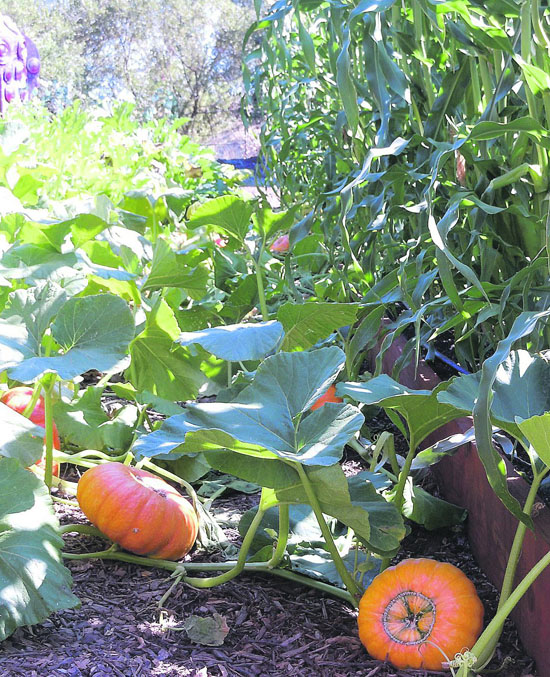 |
| Thump a pumpkin and scrape your fingernail over the shell. If it doesn't pierce, cut the stem to harvest. |
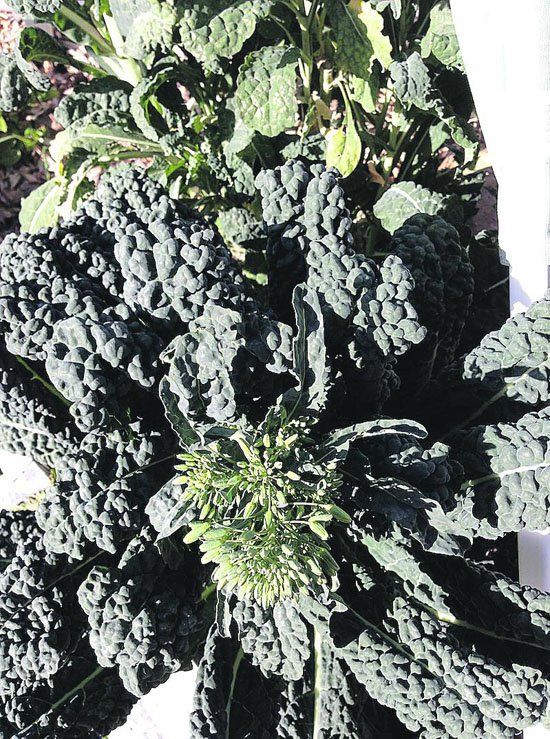 |
| Dinosaur kale blooms and sets edible seeds. Eat the blooms and the leaves. |
 |
| A beautiful bowl of sun-ripened tomatoes in several colors tossed with cilantro makes a delicious autumn salad. |
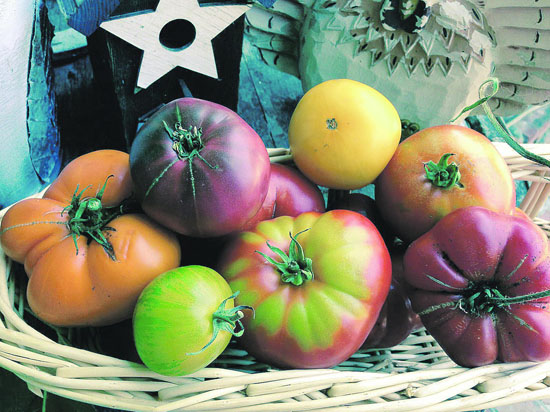 |
| A basket of fresh picked tomatoes. |
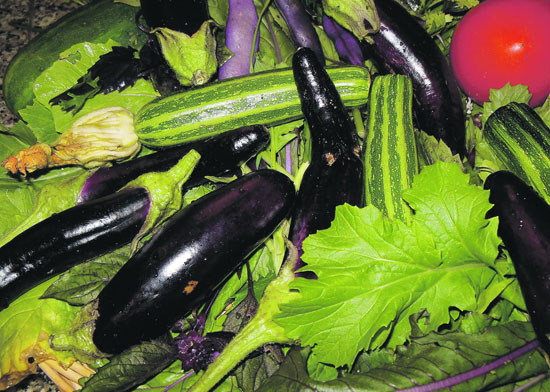 |
| Eggplant, zucchini, beans, lettuces, and tomatoes are ready for the table. |
|
|
|









